
Spitting spiders (Scytodidae) is a family of araneomorph spiders first described by John Blackwall in 1864. It contains over 250 species in five genera, of which Scytodes is the best-known.

John Blackwall was an English naturalist with a particular interest in spiders.

The spider genus Steatoda, in the family Theridiidae, includes about 120 recognized species, distributed around the world. One common name is cupboard spider, for many species build their webs in dark, sheltered, undisturbed places around the house or garden, in sheds and garages, under garden, in compost bins, and the like. Signs of the cupboard spider include small white spots of spider droppings, like small splashes of paint, on the floor underneath the web.
This is a list of the known wild biota of the Isle of Man.

Savignia is a genus of sheet weavers that was first described by John Blackwall in 1833. The name honors the French naturalist Marie Jules César Savigny.

Agroeca brunnea is a species of spider in the family Liocranidae. It is found in the Palearctic realm and was first described by John Blackwall in 1833.
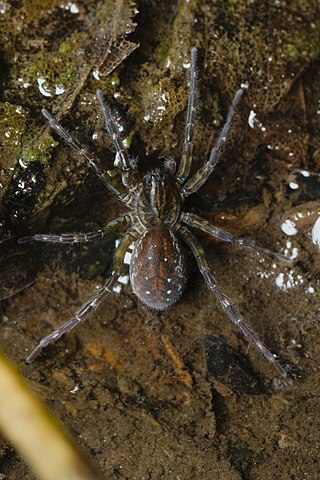
Piratula is a genus of wolf spiders first circumscribed in 1960. Its 26 species are found mainly in Asia, with a few found in Europe and North America.
Myrmage dishani is a species of spiders of the genus Myrmage. It is endemic to Sri Lanka. The species was first found from Eastern part of Sinharaja Forest Reserve. The species can easily identified by the round opisthosoma, without any visible, constrict. However, the species is much similar to Myrmage imbellissyn.: Myrmarachne imbellis.

Heliophanus cupreus, the copper sun jumper, is a species of jumping spider belonging to the family Salticidae.

Bolyphantes is a genus of dwarf spiders that was first described by Carl Ludwig Koch in 1837.
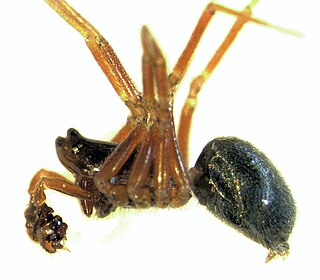
Diplocephalus is a genus of sheet weavers first described by Philipp Bertkau in 1883.

Sintula is a genus of sheet weavers that was first described by Eugène Louis Simon in 1884.
Heliophanus lesserti is a jumping spider species in the genus Heliophanus. It was first described by Wanda Wesołowska in 1986 and lives in Central and Southern Africa. Fitting with the arachnid classification, the spider's body features consists of a front cephalothorax and a back abdomen. The Heliophanus lesserti jumping spider has a primarily black colored body with light yellow and gold accents. The front legs are notability thicker than the rest while the back four having light yellow details. The part of the back abdomen that is attached to the cephalothorax has a light yellow coloring surrounding the edge.

Centromerus sylvaticus is a species of sheetweb spider in the family Linyphiidae. It is found in North America, Europe, Turkey, a range from Russia, China, Korea, and Japan.
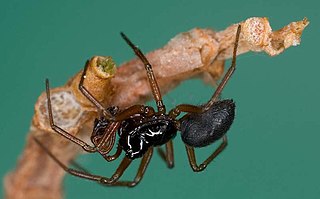
Erigone atra is a species of dwarf spider or money spider, in the family Linyphiidae. It is commonly found in North America, Europe, parts of Russia, Central Asia, China, Mongolia, Korea, and Japan. This spider is one of the most common Erigone spiders. E. atra is an important spider for agriculture, as it preys on pests such as aphids which are commonly found on crops. E. atra spiders are aeronautical spiders, as they travel via ballooning. This technique, sometimes referred to as kiting, allows E. atra spiders to traverse large distances and find new habitats when environmental or human stresses create unfit living environments. E. atra is difficult to differentiate from other congeneric species because of their similar sizes and coloring.
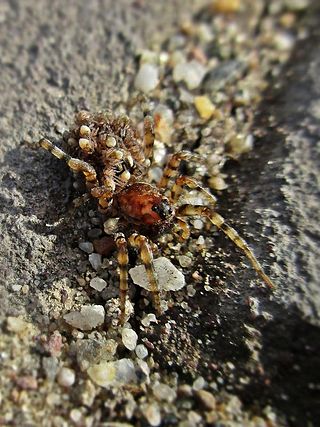
Arctosa perita, also known as the sand bear spider, is a species of wolf spider in the family Lycosidae. They are native to Europe, North Africa, Turkey, the Caucasus, and Russia, however they have also been introduced into Canada. They live on dry, sandy soils or coastal dunes, where they create their burrows.
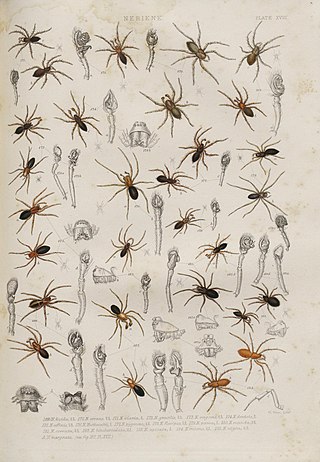
Dicymbium nigrum is a species of dwarf spider in the family Linyphiidae. It is found in Europe, Turkey, Caucasus, a range from Russia to Central Asia, and China.
Pityohyphantes cristatus is a species of sheetweb spider in the family Linyphiidae. It is found in the United States.
Araeoncus humilis is a species of sheet weaver spider.













